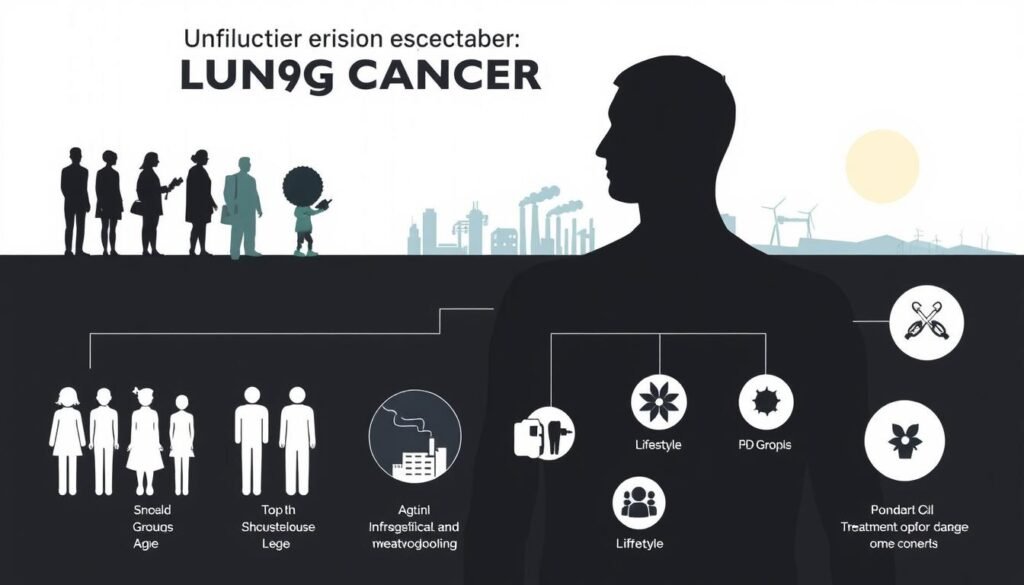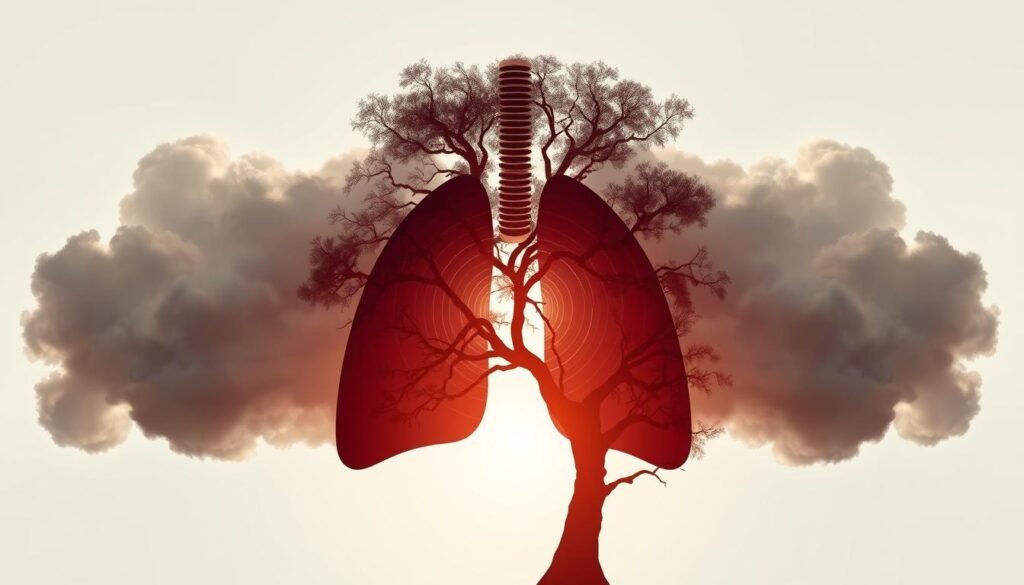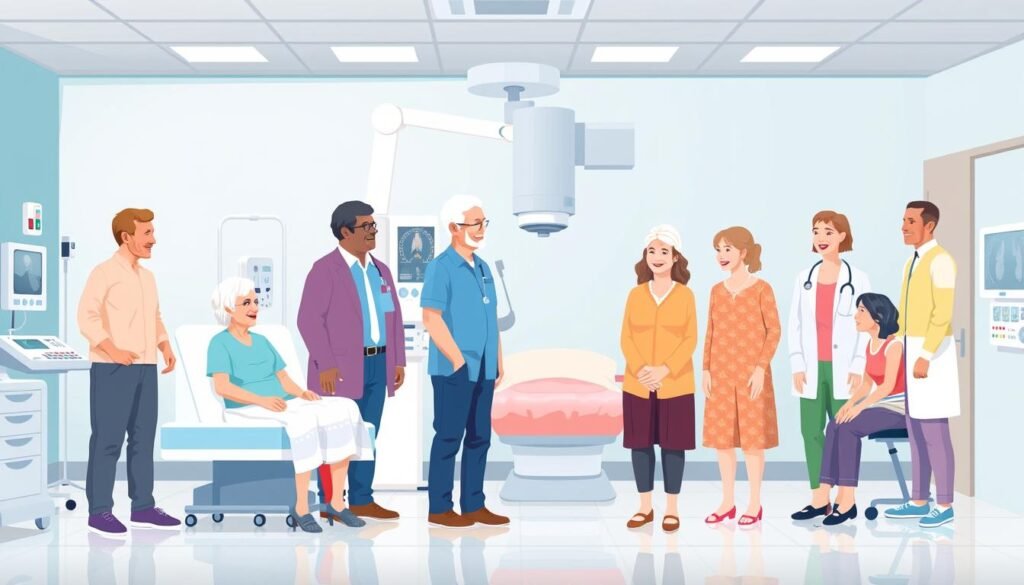Lung cancer is the top cause of cancer deaths in the US. It leads to more deaths each year than breast, prostate, and colon cancers combined. However, treatment advances are improving survival rates based on age. The prognosis for lung cancer depends on factors like age, type, stage, and the patient’s health. The American Cancer Society says most people diagnosed are over 65. This shows how age affects lung cancer prognosis and helps with treatment decisions.
To stay ahead, it’s vital to know about lung cancer survival by age. For non-small cell lung cancer, survival rates differ a lot by stage when found. If caught early, the survival rate is 65%. But at stage 4, it drops to 5%. Learning about lung cancer survival by age can guide your expectations. For a deeper insight into these trends, check out lung cancer survival rates by age here.
Key Takeaways
- Lung cancer survival rates can vary significantly by age.
- The average age for lung cancer diagnosis is around 70 years old.
- Localized lung cancer has a relatively high survival rate of 65%.
- Being informed about lung cancer life expectancy by age helps in making treatment decisions.
- Age, overall health, and cancer type play critical roles in prognosis.
Lung Cancer Overview
Lung cancer is a big health concern today, affecting many people. There are two main kinds: non-small cell lung cancer (NSCLC) and small cell lung cancer (SCLC). NSCLC makes up about 80-85% of all cases. It grows slower than SCLC, which is about 10-15% of cases but grows quickly.
The stats on lung cancer are serious. The National Cancer Institute says the median survival rate is one year without treatment. Only about 20% live longer than five years after their diagnosis. This shows how crucial ongoing research and better treatments are, especially for older people who often get this disease.
Lung cancer is the top cause of cancer death in the U.S., causing around 20% of all cancer deaths. It kills more people than the next three leading cancers put together. The survival rate for NSCLC is 60% after 5 years if it’s found early. But, it drops to 6% for advanced cases. SCLC’s survival rate goes from 29% to just 3% when it’s advanced.
However, there’s hope. Lung cancer treatments are getting better, and finding it early helps. Yet, it’s still more deadly than most cancers, except pancreatic cancer. The key to fighting lung cancer lies in knowing more about it and catching it early. This can help save lives.
Understanding Lung Cancer Types
Lung cancer comes in two main types: non-small cell lung cancer (NSCLC) and small cell lung cancer (SCLC). NSCLC has different forms, like adenocarcinoma, squamous cell carcinoma, and large cell carcinoma. Adenocarcinoma is the most common.
SCLC is known for being aggressive and quick to spread. It’s important to know the difference between these types. This knowledge helps in choosing the right treatment for patients.
The chances of surviving NSCLC are often higher than SCLC. About 65% of people with NSCLC in early stages live for at least five years after diagnosis. But, for SCLC, the rate is much lower, about 7%. This shows why catching the disease early and getting the right treatment matters so much.
| Type of Lung Cancer | Five-Year Survival Rate (Localized) | Five-Year Survival Rate (Distant) |
|---|---|---|
| Adenocarcinoma (NSCLC) | 61.6% | 6.0% |
| Squamous Cell Carcinoma (NSCLC) | 49.4% | 7.5% |
| Large Cell Carcinoma (NSCLC) | 61.6% | 6.0% |
| Small Cell Lung Cancer | 33.3% | 3.9% |
Knowing the differences between NSCLC and SCLC helps patients and doctors. It leads to better awareness, early detection, and smarter treatment choices.
Lung Cancer Prognosis by Age
Lung cancer’s outlook changes a lot with age, affecting survival rates and treatment results. Knowing how age relates to prognosis offers insights into what lung cancer patients face.
Age and Survival Rates
Age plays a big role in how long lung cancer patients live based on their age. Data shows big differences in outcomes across age groups. Those under 50 with stage 1 lung cancer have an 83.7% chance of living five more years. But this drops to 54.6% for those 65 and older.
This information is key for doctors to choose the best treatments.
| Stage of Lung Cancer | Survival Rate Under 50 | Survival Rate 50-64 | Survival Rate 65+ |
|---|---|---|---|
| Stage 1 | 83.7% | 67.4% | 54.6% |
| Stage 2 | 83% | 67% | 54% |
| Stage 3 | 36% (Stage 3A) | 26% (Stage 3B) | 13% (Stage 3C) |
| Stage 4 | 8% (Distant NSCLC) | 3% (Distant SCLC) | 3% (Distant SCLC) |
Impact of Age on Treatment Options
Age heavily shapes how lung cancer is treated. Older patients often face other health issues, complicating their treatment paths. For instance, the elderly might not handle chemotherapy well. This makes doctors consider other methods like targeted therapies or caring treatments. When planning treatment, doctors look at both the cancer stage and the patient’s overall condition. Providing care tailored to each person is crucial, especially for older patients.
Factors Influencing Lung Cancer Prognosis
Knowing the factors influencing lung cancer prognosis is vital. It helps to evaluate treatment paths and the chances of survival. Health issues play a major role in lung cancer outcomes. How healthy someone is when they find out they have lung cancer can greatly affect their treatment success and how long they live after.
Health Status and Lung Cancer Outcomes
A patient’s health really impacts lung cancer prognosis. Research shows that healthier people have a better chance of receiving surgery, which can improve survival chances. But, those losing more than 5% body weight before treatment often see worse outcomes. Additionally, a higher performance status score means a better prognosis.
Type and Stage of Lung Cancer
The lung cancer type and stage are key to predicting outcomes. According to SEER data, the stage at diagnosis greatly influences survival rates. For early-stage non-small cell lung cancer (NSCLC) in stages 0 and 1, the five-year survival rate is about 65%. But for later stages, this number drops significantly.
Small cell lung cancer has different survival outcomes too. Those diagnosed at a limited stage have a more favorable prognosis compared to extensive stage. For detailed staging information, check this valuable resource.

| Stage of Lung Cancer | Five-Year Survival Rate |
|---|---|
| Localized NSCLC (Stage 0 & 1) | 65% |
| Regional NSCLC (Stage 2) | 37% |
| Distant NSCLC (Stage 3 & 4) | 9% |
| Limited Stage Small Cell Lung Cancer | Higher than extensive stage |
Lung Cancer Survival Rates by Age
The survival rates for lung cancer change a lot depending on how old you are. This shows us the big picture of lung cancer’s outcomes. We will look at numbers for both young and older people with lung cancer.
Statistics for Young Adults
Lung cancer in young adults is getting more attention. It has interesting survival rates. Those under 50 see better survival rates, especially with early-found lung cancer. The five-year survival rate for them can reach 83.7%.
Better overall health and catching it early help a lot. This shows young adults can fight off lung cancer well.
Statistics for Elderly Patients
But, it’s harder for older people. Survival rates drop as people get older. Those over 65 find it tough, especially with stage IV lung cancer. They only have a five-year survival rate of 4.7%.
They often find out they have cancer too late. This makes treatment hard. Age makes beating cancer tougher, impacting how well treatments work.
| Age Group | 5-Year Survival Rate (Localized Cancer) | 5-Year Survival Rate (Stage IV) |
|---|---|---|
| Under 50 | 83.7% | 11% |
| 50-64 | Variable | 7% |
| 65 and Older | Variable | 4.7% |
Looking at these statistics shows how age greatly affects lung cancer survival rates. It changes the treatments people get and their experiences with the disease.
Lung Cancer Life Expectancy by Age
Age plays a key role in lung cancer life expectancy. Statistics show that younger patients tend to live longer. This starkly contrasts with older individuals’ prognosis.
Let’s look at the numbers for clarity. About 83.7% of people under 50 beat stage 1 non-small cell lung cancer (NSCLC) for five years or more. This rate falls to 67.4% for those 50 to 64 years old. And it drops again to 54.6% for those 65 and up. These life expectancy statistics lung cancer clearly show how crucial age is.
Exploring survival rates, small cell lung cancer (SCLC) shows a five-year survival of only 8.6%. Meanwhile, non-small cell lung cancer (NSCLC) varieties offer brighter prospects. For example, 22.8% for large cell and 25.2% for squamous cell cancers.
Age influences treatment choices, affecting life expectancy. Older folks often grapple with more health issues, making treatment complex. It highlights the need for personalized care based on age and health.
Early detection and treatment can raise survival chances. Stage 1 NSCLC patients may see a five-year survival rate up to 92%. Knowledge of new treatments gives hope to older patients seeking to extend their lives.

Lung Cancer Stages and Age
Lung cancer stages and age play a big role in patient outcomes. Older people often find out they have lung cancer at a later stage. Knowing the stage early on is key to improving survival rates. For example, stage 1 lung cancer has the best results.
Stage Related Survival Differences
Studies show big differences in survival rates between lung cancer stages. This shows how crucial early detection is. For non-small cell lung cancer (NSCLC) caught early, the 5-year survival rate is about 63.7%. But this drops to 4.7% for stage 4 cancer. Older people are more likely to be diagnosed with late-stage cancer. This makes their treatment harder and shortens their life expectancy.
The next table shows how survival rates for lung cancer change with age and stage:
| Stage | Under 50 | 50-64 | 65 and Older |
|---|---|---|---|
| Localized NSCLC | 83.7% | 67.4% | 54.6% |
| Regional NSCLC | 47.7% | 36.6% | 28.3% |
| Distant NSCLC | 11% | 7% | 4.7% |
Understanding lung cancer stages helps explain survival rates. It also shows why regular screenings are vital. The link between staging and age shows we need ways to help older people get diagnosed earlier. This can lead to more personalized treatment plans. Click here to learn more about the impact of staging on prognosis
Lung Cancer Treatment Options by Age
Treatment strategies for lung cancer differ by age. The type of lung cancer, its stage, and overall health shape the choices. Older patients face unique challenges. They might deal with complications that limit their treatment options, like surgery or chemotherapy. Studies show that patients over 75 often receive less aggressive treatments. These methods focus on comfort and quality of life, considering the patient’s health and wishes.
Choosing the right lung cancer treatment for each age involves careful evaluation. For older patients, getting a histological confirmation is key to decide on a treatment. Now, targeted therapies and immunotherapy are more common for treating lung cancer in older people. These options have fewer side effects and are easier on patients compared to traditional chemotherapy.

| Age Group | Treatment Options | Common Strategies |
|---|---|---|
| 15-39 | Aggressive treatments | Chemotherapy, surgery, radiation |
| 40-64 | Combination therapies | Targeted therapy, chemotherapy |
| 65-74 | Personalized treatments | Immunotherapy, radiation |
| 75+ | Supportive care | Palliative approaches, less intensive protocols |
The treatment strategies for lung cancer are changing as new advancements improve survival rates. Knowing about these treatments helps patients and their families. They can talk to doctors about the best options for their situation. This knowledge allows for better, informed choices.
Lung Cancer Risk Factors by Age
Age is a big lung cancer risk factor. Most new cases are found in people over 65. The highest rates are in those 75 to 79, then 80 to 84 years old.
Smoking is the top cause of lung cancer, leading to 80%-90% of deaths. Even secondhand smoke ups the risk by 20%-30%. These facts show how age and factors like smoking are linked.
Black men have a 15% higher risk of lung cancer than white men. In contrast, Black women’s risk is 14% lower than white women’s. Age plays a role here, as older people often have other health issues.
Older patients usually live about 37.8 weeks after diagnosis, younger ones about 57 weeks. Knowing age-related risks helps improve screening. This could lead to better outcomes. For more on early detection, click here.
Conclusion
Lung cancer’s outlook varies with age, showing that age impacts survival rates and how well treatments work. Young adults, for instance, often have better survival odds than older people. They have a 1-year survival rate of about 62.31%. This number drops sharply in older groups, especially as lung cancer gets worse.
The type and stage of lung cancer play big roles in how age affects outcomes. The overall health of the patient is also crucial. Adenocarcinoma is often seen in younger individuals. Yet, having stage IV disease typically means a survival of only 10 months. If a patient has certain genetic mutations, they might respond better to treatment. This shows why treatments should be chosen based on the patient’s unique situation.
Continued research into lung cancer will help doctors and patients make better decisions. With deeper knowledge on how age influences prognosis, they can set more accurate expectations. They can also improve treatment methods. The goal is to enhance survival rates for people of all ages.